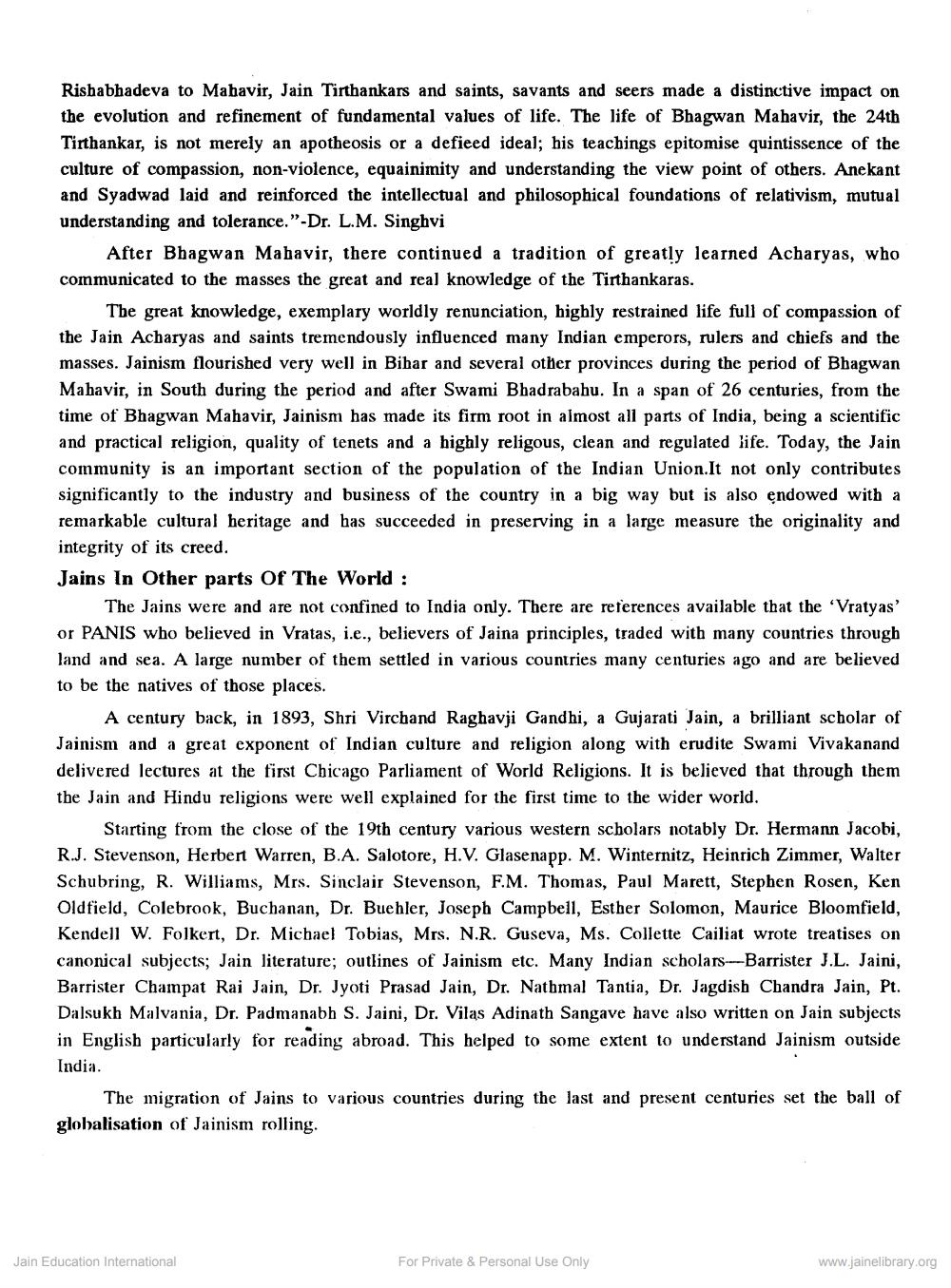________________
Rishabhadeva to Mahavir, Jain Tirthankars and saints, savants and seers made a distinctive impact on the evolution and refinement of fundamental values of life. The life of Bhagwan Mahavir, the 24th Tirthankar, is not merely an apotheosis or a defieed ideal; his teachings epitomise quintissence of the culture of compassion, non-violence, equainimity and understanding the view point of others. Anekant and Syadwad laid and reinforced the intellectual and philosophical foundations of relativism, mutual understanding and tolerance."-Dr. L.M. Singhvi
After Bhagwan Mahavir, there continued a tradition of greatly learned Acharyas, who communicated to the masses the great and real knowledge of the Tirthankaras.
The great knowledge, exemplary worldly renunciation, highly restrained life full of compassion of the Jain Acharyas and saints tremendously influenced many Indian emperors, rulers and chiefs and the masses. Jainism flourished very well in Bihar and several other provinces during the period of Bhagwan Mabavir, in South during the period and after Swami Bhadrababu. In a span of 26 centuries, from the time of Bhagwan Mahavir, Jainism has made its firm root in almost all parts of India, being a scientific and practical religion, quality of tenets and a highly religous, clean and regulated life. Today, the Jain community is an important section of the population of the Indian Union.It not only contributes significantly to the industry and business of the country in a big way but is also endowed with a remarkable cultural heritage and has succeeded in preserving in a large measure the originality and integrity of its creed. Jains In Other parts Of The World :
The Jains were and are not confined to India only. There are references available that the 'Vratyas' or PANIS who believed in Vratas, i.e., believers of Jaina principles, traded with many countries through land and sea. A large number of them settled in various countries many centuries ago and are believed to be the natives of those places.
A century back, in 1893, Shri Virchand Raghavji Gandhi, a Gujarati Jain, a brilliant scholar of Jainism and a great exponent of Indian culture and religion along with erudite Swami Vivakanand delivered lectures at the first Chicago Parliament of World Religions. It is believed that through them the Jain and Hindu religions were well explained for the first time to the wider world.
Starting from the close of the 19th century various western scholars notably Dr. Hermann Jacobi, R.J. Stevenson, Herbert Warren, B.A. Salotore, H.V. Glasenapp. M. Winternitz, Heinrich Zimmer, Walter Schubring, R. Williams, Mrs. Sinclair Stevenson, F.M. Thomas, Paul Marett, Stephen Rosen, Ken Oldfield, Colebrook, Buchanan, Dr. Buehler, Joseph Campbell, Esther Solomon, Maurice Bloomfield, Kendell W. Folkert, Dr. Michael Tobias, Mrs. N.R. Guseva, Ms. Collette Cailiat wrote treatises on canonical subjects; Jain literature; outlines of Jainism etc. Many Indian scholars--Barrister J.L. Jaini, Barrister Champat Rai Jain, Dr. Jyoti Prasad Jain, Dr. Nathmal Tantia, Dr. Jagdish Chandra Jain, Pt. Dalsukh Malvania, Dr. Padmanabh S. Jaini, Dr. Vilas Adinath Sangave have also written on Jain subjects in English particularly for reading abroad. This helped to some extent to understand Jainism outside India.
The migration of Jains to various countries during the last and present centuries set the ball of globalisation of Jainism rolling.
Jain Education International
For Private & Personal Use Only
www.jainelibrary.org




